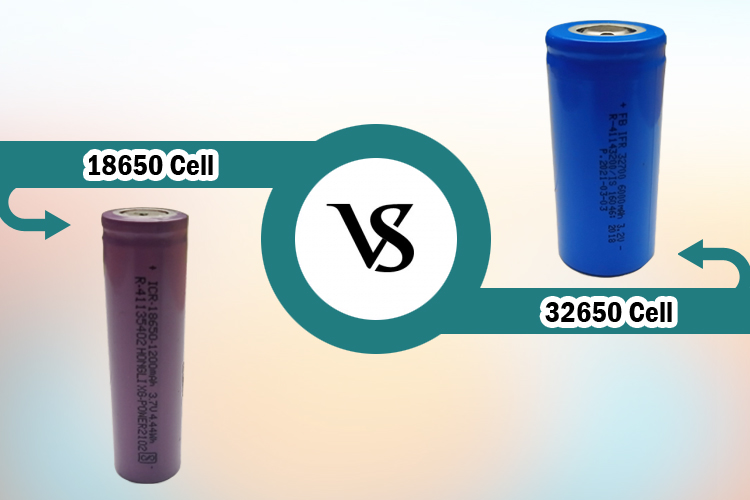
Li-ion cells are becoming the most desirable energy storage system for more and more applications with every passing day due to their high energy density and other benefits these cells have to offer. Lithium-Ion cells are used in various applications which have different energy needs and demands, and to suffice all the different needs, different chemistries of Li-ion cells are used. Li-ion cells are of different types and you can learn more about them in one of our previous articles about Li-Ion cells.
Here in this article, I will be discussing and comparing the 18650 NMC cell with the 32650 LFP cells. The goal of this article is to help you select the most suitable battery for your next project. 32650 are also called 32700 cells and have a form factor of D-type cell. D-type cells were commonly used for powering high-intensity flashlights and radios. You can also check out the article on different types of batteries if you want to learn more about batteries in general.
Note: In this article, we are comparing 18650 NMC cells with 32650 LFP cells. We are comparing 2 different chemistries in 2 different form factors as they are most popular in their respective from factor. Here forth, 18650 refers to 18650 NMC and 32650 refers to 32650 LFP.
What does the number 18650 or 32650 signify in a Cell?
The 18650/32650 in the cell tells us about the shape and size of the cell. The 32650 is also known as the D-type cell. The nomenclature of the cell can be easily understood by splitting the numbers into 3 parts as shown in the image below:
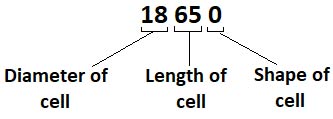
The first 2 numbers tell us about the diameter of the cell in millimeters, the 3rd and 4th numbers tell us about the height of the cell while the last digit tells us about the shape of the cell.
From the above explanation, it can be clearly understood that the 18650 cell is cylindrical in shape with a diameter of 18mm and a height of 65mm. whereas the 32650 cell has a diameter of 32mm and a height of 65mm. The graphical size comparison of the 2 cells is shown below.
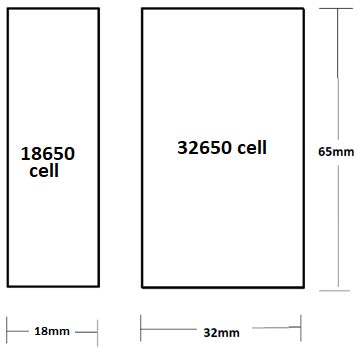
Battery Chemistry of 18650 NMC vs 32650 LFP Cells
Like any other cell, both the 18650 and 32650 li-ion cells have 4 main components that are Cathode, Anode, Electrolyte, and Separator.
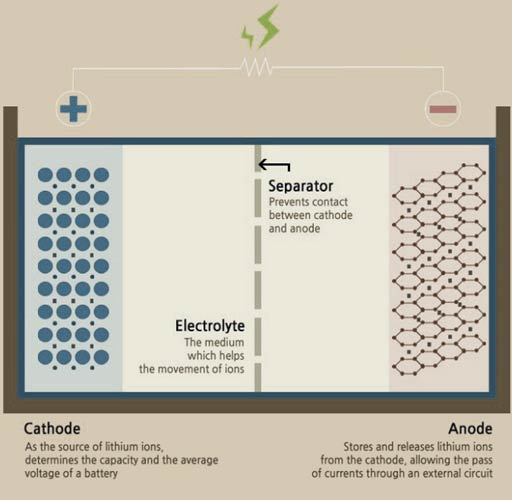
Lithium-ion cells have a lot of different chemistries, and these chemistries affect the property of a cell drastically. In this article, 18650 with Nickle Manganese Cobalt (NMC) chemistry and 32650 with Lithium Iron Phosphate (LFP) chemistry are being compared.
Characteristics of 18650 with NMC
Lithium Nickle Manganese Cobalt Oxide or NMC cells are one of the most common chemistry used in the 18650 cells. These cells have a nominal voltage of 3.7 V with an energy density of 150-220 Wh/kg. These batteries have a higher energy density than the LFP cells.
NMC cells are used by many major EV manufacturers, some cars where these NMC batteries are used are BMW i8, Audi e-Tron GE, Jaguar I-Pace, and is also popular in some budget-friendly cars such as VW e-Golf, Nissan Leaf, etc. Apart from EVs, these cells are also used in medical equipment, ESS, power tools, etc.
Characteristics of 32650 with LFP
Lithium Ferro Phosphate or LFP cells with cell chemistry LiFePO4 are in high demand these days due to their long-life cycle, thermal stability, and low self-discharge rates. LFP cells have a low nominal voltage of 3.2V and a lower energy density of 90-160 Wh/kg. But the lower cost, higher durability, and high self-discharge rates make them very lucrative. And the lower energy density is negated by using this chemistry in bigger cells such as the 32650.
LFP batteries are preferred in making battery packs for energy storage systems, solar-powered lighting systems, and in e-rikshaws, forklifts, power equipment, and EV cars. Tesla has lately announced to switch to LFP cells for their newer model 3.
Advantages of 18650 Cells over 32650 Cells
Higher Energy Density:
Higher energy density means that the NMC cells will be smaller and lighter for the similar capacity battery pack.
Smaller form factor of individual cell:
The smaller form factor makes 18560 NMC cell more appropriate for application with very low energy requirements, such as
Cheaper:
The 18650 NMC cells are cheaper than the 32650 LFP cells for equivalent capacity cells. This makes 18650 NMC cells a better option for hobbyists and the proof of concept phase.
Higher Nominal Voltage:
The 18650 NMC cells have a nominal voltage of 3.7 Volts compared to 3.2Volts of 32650 LFP cells. The higher nominal voltage means that a lower number of cells are required in series for making a battery pack of higher voltage thus reducing the size, cost, and complexity of the system.
For example: if we want to design a 50 Volt battery pack, the minimum number of cells required in series for NMC and LFP are 14 and 16 respectively.
Advantages of 32650 Cells over 18650 Cells
Safer:
LFP cells are thermally more stable than the NMC cells, as shown in the below graph, the LFP cells enter thermal runaway condition at almost twice the temperature that is required for the NMC cells, i.e. 280 °C vs 150 °C and the energy released during thermal runaway is less than 3rd of that of the NMC cell. This makes LFP cells much safer than NMC cells.
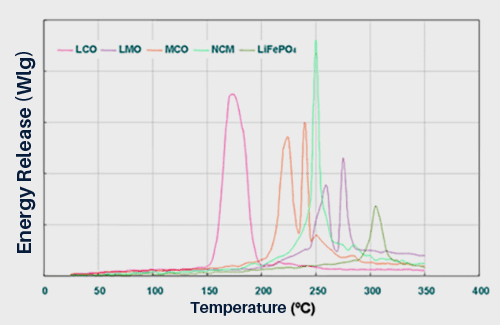
Longer lifecycle:
The LFP cells have a much longer life cycle. LFP cells can have over 2500 charge cycles compared to 1000 charge cycles of NMC cells before reaching 80% of the original capacity. This also means that over the time LFP cells will have lower running cost and is more suitable for long term applications.
Higher discharge current:
The LFP chemistry can supply a discharge current of 1C and some cells can supply more than 10C while the discharge current for NMC cells is 1-2C. But when we take into consideration the capacity of our 18650 cells and 32650 cells, even at the same 1C discharge rate, the 32650 LFP cells will provide 2 to 3 times the discharge current that of 18650 LFP cells. The explanation is given later in the article.
The higher discharge rate makes 32650 cells more suitable for operations with higher current requirements such as motor control, power tools, forklifts, or for powering heavy industry equipment.
Difference between 18650 Lithium Cells and 32650 LFP Cells
Both the 18650 NMC cell and 32650 LFP cell have their own advantages and disadvantages. The table below compares the characteristics of both the cell’s chemistry.
|
|
Lithium Iron Phosphate(LiFePO4) — LFP |
|
|
Voltages |
3.70 nominal voltage |
3.20 nominal voltage |
|
Typical operating range |
3.0–4.2V |
2.5–3.65V |
|
Specific energy (capacity) |
150–220Wh/kg |
90–120Wh/kg |
|
Charge (C-rate) |
0.7–1C, charges to 4.20V, some go to 4.30V |
1C typical, charges to 3.65V |
|
Discharge (C-rate) |
1C; 2C possible on some cells; 2.50V cut-off |
1C, 25C on some cells; 40A pulse (2s); 2.50V cut-off |
|
Cycle life(80% left) |
1000-1500 |
2500 - 3000 |
|
Thermal runaway |
150°C |
270°C |
|
Advantages |
Provides high capacity and high power. Serves as Hybrid Cell. Favorite chemistry for many uses; market share is increasing. |
Very flat voltage discharge curve but low capacity. One of safest
|
|
Applications |
E-bikes, medical devices, EVs, industrial |
Portable and stationary needing high load currents and endurance |
Comparing 18650 vs 32650 with Similar Chemistry
In the above section, we have compared 18650 NMC cells with 32650 LFP cells because these are the most common cells in the respective form factors. Now onwards, I am comparing just the formfactor. I will compare the volume, capacity, discharge rate so that you can decide which chemistry and formfactor you need to select for your application.
Volume of Cell:
The volume of the cell is an important parameter because the capacity of the battery depends on the size of the electrodes. Therefore, volume directly affects the capacity of a cell. The volume of a cell is given by:
V=πr2h Volume of 18650 = 52.28 cm2 Volume of 32650 = 209.1 cm2
From the above data, it is clear that the volume of a 32650 cell is almost 4 times that of a 18650 cell, hence theoretically a 32650 Li-ion cell should hold approximately 4 times the energy that of a 18650 cell.
Comparing Capacity:
The capacity of a Li-ion cell is measured in mill-amp-hour or mAh. The capacity of the battery dictates how long a battery will last. Cells having higher capacity last longer than cells with lower battery capacity. The capacity of cells depends on the size of the electrode materials. Therefore, a bigger battery will have a higher capacity.
Hence, the capacity of 32650 cells is higher than that of 18650 cells, therefore it is capable of lasting longer than a 18650 cell in similar applications.
Discharge rate of 18650 vs 32650:
Discharge rate is a very important parameter that tells us about the amount of current that can be drawn from the cell without causing degradation to the cell. It depends on the chemistry and design of the cell and is measured in C-rate. The discharge rate of a battery is associated with the capacity of a battery. For eg., a 2000mAh cell will have a 1C rate if it provides a continuous current of 2000 mA.
Usually, a battery gives details about 2 discharge rates, maximum discharge rate, and continuous discharge rate. The maximum discharge rate refers to the maximum charge a battery can give but it is used only for short bursts while the continuous discharge rate refers to the amount of power a battery can discharge continuously for longer periods of time. Since the rate of the discharge depends on the capacity of a cell, therefore the rate of discharge of 32650 will be higher than that of a 18650 cell.
For eg., if we have 2 cells, the 1st 3600 mAh 18650 cell and the 2nd cell is 6000 mAh 32650. Both the cells have a continuous discharge rate of 2C. then the maximum current drawn by the 1st and 2nd cell will be 7.2A and 12A.
So, from the above example, it is clear that 32650 will be able to provide higher currents, but in practical applications, the discharge rate depends on many factors such as the internal structure and chemistry of cells. So, when the C-rates are the same, 32650 cells having higher capacity will have higher current discharging capabilities.
18650 vs 32650 Applications:
The selection of a cell depends on multiple factors such as the amount of current and power is required by a device. From the information provided above, it is clear that the size and volume of 18650 are smaller which makes it compact but the downside is that it has a lower capacity and discharge rate compared to a similar 32650 cell. Hence, for low-powered applications such as powering an embedded system, or small electronic equipment which has lower current requirements, a 18650 cell is more suitable. Whereas, for applications with higher power requirements such as power tools, high-powered flashlights, etc. where the current requirement is extremely high, 32650 cells are more suitable. Furthermore, 32650 cells have higher.
Conclusion
Comparing a 18650 NMC cell with a 32650 LFP cell is not fair, but availability in the respective combination makes it a crucial factor to decide. The 18650 cell is cheaper than the 32650 LFP cells, but due to the longer lifespan of the 32650 cells, it is less suitable for applications having longer lifetimes. The size and energy density of 18650 makes it more optimum for low-powered applications which have an operating life of 2-3 years. And even though the 18650 Li-ion cells are sold more than the 32650 Li-ion cells, it doesn’t mean that they are better. The 32650 cells usually have higher energy capacity and higher discharge rates compared to 18650 of similar chemistry, making 32650 cells more desirable for energy extensive equipment such as power tools. Nevertheless, a cell should be carefully selected depending on the purpose and requirement of the equipment.
I hope that you enjoyed reading the article and if you have any doubt related to energy storage and batteries, please write them in the comments below.






This is a very good and understandable article for educated and most laypersons.